The Samsung Galaxy S7 & S7 Edge Review, Part 1
by Joshua Ho on March 8, 2016 9:00 AM ESTDisplay
As always, the display of any mobile device is a critical part of the overall user experience. A poor display in any way is often going to sour the entire experience.
On a personal note, there are a number of mobile devices that I’ve used over the course of the previous year that frankly just weren’t good enough for me to use as a daily driver because the display just wasn’t good enough. My laptop is quite closely calibrated to sRGB and it’s used to edit all of my device photos, so I’ve really come to appreciate a device that has sufficiently accurate color that I can actually use a phone or tablet as a reference monitor of sorts to verify that images look the way I want them to.
In order to test this critical portion of the user experience, we turn to our standard test suite which uses SpectraCal’s CalMAN 5, a custom workflow for testing basic metrics like brightness, contrast, and calibration accuracy, and X-Rite’s i1Pro2 and i1DisplayPro.
Starting off with a microscope's view of the Galaxy S7's display, it looks like Samsung has elected to keep most aspects of the display constant when comparing the Galaxy S6 and S7. At a high level, the display is the same 5.1” display size that we’ve seen for a few generations now, and the 1440p resolution is shared with previous devices. Samsung continues to use their diamond PenTile layout, but it’s hard for me to say whether there’s been an adjustment to the size of the emitters as the microscope I have on hand isn’t quite sufficient for making such measurements. It’s likely that under the hood there are changes to the display driver IC in order to enable features like Always-On Display, but as we’ll soon see it’s rather unlikely that there are any generational changes in things like the emitter material or TFT backplane.
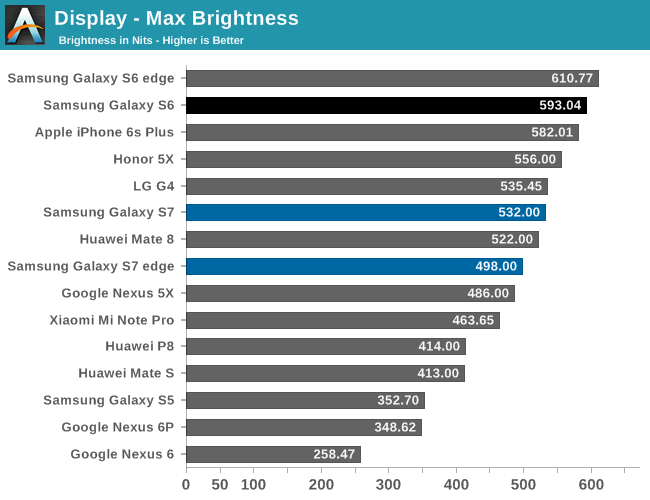
One of our first tests here is a pretty standard test of maximum luminance. Here, we see that the Galaxy S7 and S7 edge both are in the same general ballpark as the Galaxy Note5, which suggests that both devices are likely to be in the same generation of AMOLED panel. This brightness was achieved by using the auto-brightness mode, so it’s important to note that the max luminance in manual mode will be much lower. Of course, this brightness figure was determined with a full white display so reducing the APL will result in a higher maximum luminance as the power budget can we spent on fewer pixels which means that a higher duty cycle can be achieved in each pixel.
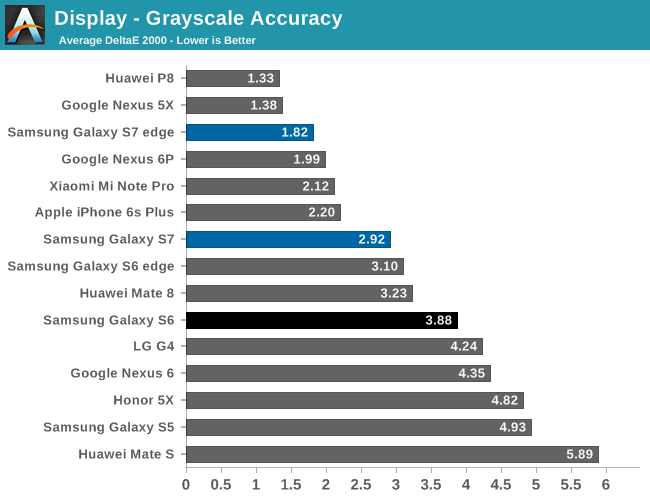
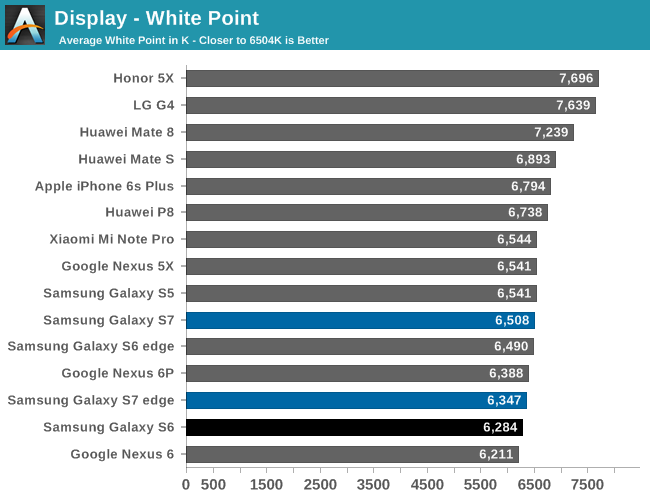
The next part of our testing is grayscale. As always, we target the industry standard of a 2.2 power gamma with 6504k white point. Relative to the Galaxy S6 and Note5, we see a pretty significant improvement in white point accuracy as it’s pretty much consistently quite close to a neutral white rather than a warmer color balance. Unfortunately though, in both review units I received the display has a noticeable green tint for many shades of grey, which seems to be somewhat of a perpetual problem with Samsung AMOLED displays. This really does affect quite a bit of the UI, as Material Design greys have this noticeable green tint to them that really makes things look off.
The same issue seems to not be present on the Galaxy S7 edge, which leads to a significant improvement overall in calibration quality for this portion of the testing, but both devices have a noticeably lower gamma than expected, which does have some effect on accuracy but for the most part can help to serve as a compensation mechanism for reflectance when dealing with ambient light. It’s likely that the green tint issue may only appear on a device to device basis, but to see that such issues haven’t been resolved for years is somewhat concerning given that phones costing hundreds of dollars less don’t seem to have the same problems.
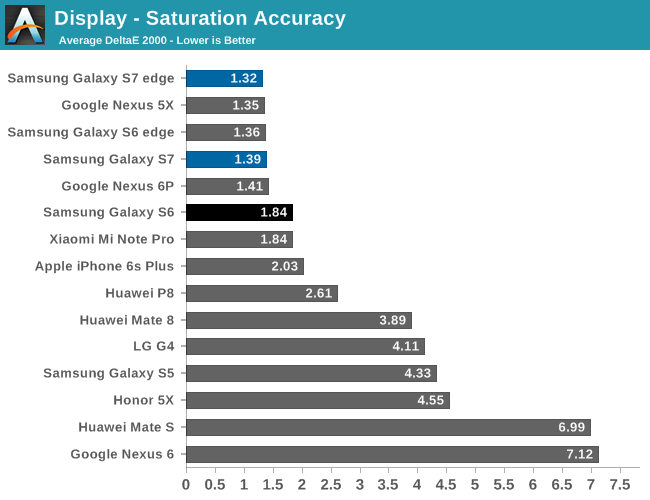
The next portion of our testing is the standard saturation sweep test. Here, the Galaxy S7 and S7 edge are basically perfect. It’s great to see that Samsung continues to provide their Basic color mode with a real focus on providing accurate color calibration for those that care about these things, and the user experience with getting to the right color calibration is pretty much as painless as it can be compared to some other devices where things like saturation curves, white balance, and other parts of a display calibration can only be adjusted using unitless sliders that basically require a spectrophotometer to actually use.

In our Gretag MacBeth ColorChecker test, we see that there are some issues with grayscale accuracy, but overall color accuracy remains quite good. In terms of overall display quality, I don’t really think there’s any meaningful improvement over the Galaxy S6, but that’s mostly because the Galaxy S6 set a ridiculously high bar for display quality.
However, I don’t believe that Samsung has run out of things to improve for future AMOLD displays. In addition to the grayscale problems mentioned earlier, Samsung clearly has not resolved issues with color shifting that occurs with viewing angle changes. LCDs definitely have more luminance degradation as you move away from the normal of the display plane, but at almost every angle change I can see whites get noticeably colder and interference patterns, in addition to a general color shift that is noticeably more than most LCDs used in high end smartphones and tablets. It’s obvious that this is a hard problem to solve due to uneven subpixel aging, but for things like tablets, laptops, and desktops color shifting is going to be a much more significant issue.


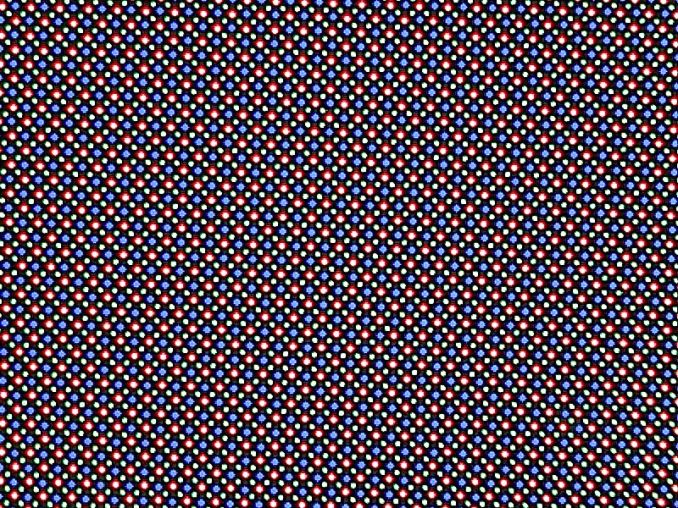

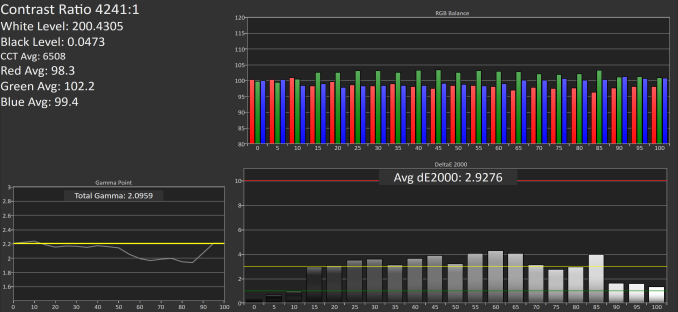


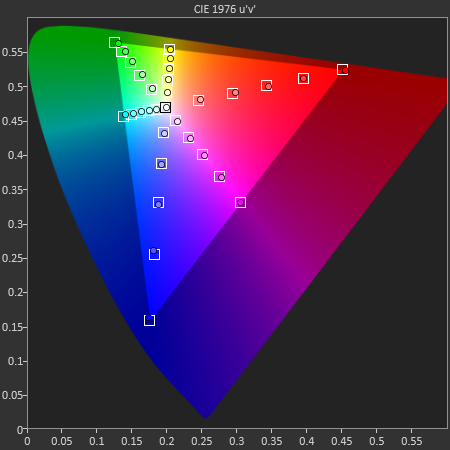
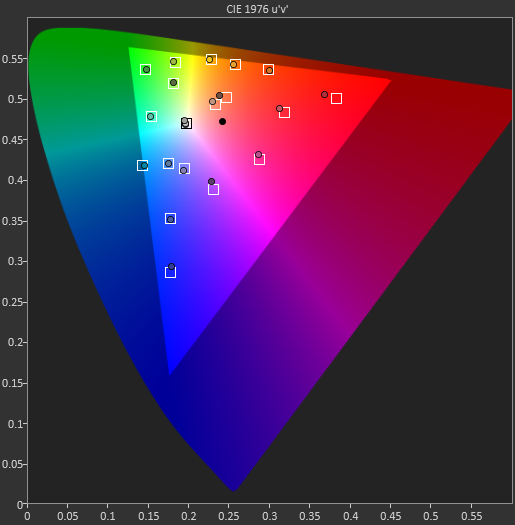
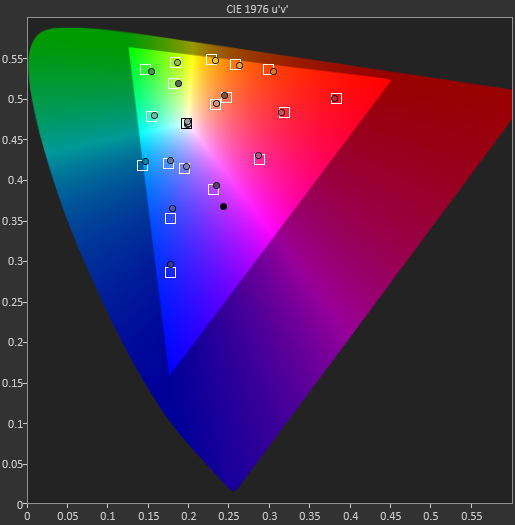








202 Comments
View All Comments
kamhagh - Sunday, March 13, 2016 - link
Another terrible phone :Sgfieldew - Sunday, March 13, 2016 - link
I have an Exynos variant of the S7. I ran the browser based tests for you.Kraken 1.1 - 2553
Octane 2.0 - 12602
WebXPRT - 168
gfieldew - Sunday, March 13, 2016 - link
Sorry, I should have mentioned that I used the Samsung version of the AOSP Browser called simply Internet.lilmoe - Sunday, March 13, 2016 - link
Andrei,Just got my GS7 Edge and ran your NAND benchmark (4K random 256K sequential).
I'm getting:
*sequential: 524.43 MB/s read, 149.03 MB/s write
*random: 76.76 MB/s read, 14.99 MB/s write
What are your exact settings in AndroBench?
lilmoe - Sunday, March 13, 2016 - link
Sorry, I meant to address Joshqasdfdsaq - Wednesday, March 23, 2016 - link
Yeah, I'm getting similar results to you (~400 read, 140 write, 80/15 random) on the S7, both with AndroBench and several other benchmarks. Those numbers in the article look... offqasdfdsaq - Wednesday, March 23, 2016 - link
Here's a point. Anandtech are testing the Snapdragon 820 variant, whereas my results are from the Exynos variant. Which one were you testing?lilmoe - Friday, April 15, 2016 - link
Exynos, of course.truelovv - Monday, March 14, 2016 - link
Truelovv.com is a 100% free dating site for singles and Relationship Who are looking to meet their special someone, True Lovers and after they can do romance and create a finalily relationship.True Lovv Website is Founded because When you are FREE and you want to chat someone then you can come into our website and Do Flirt, Romance, Chatting, Messaging etc. with your life partner or your True Lover. The only reason we require these forms is so we can match you with the right man or woman, and to make you feel comfortable at our site for singles dating.
http://www.truelovv.com/
Aritra Ghatak - Wednesday, March 16, 2016 - link
Can anybody provide the link to the material wall in Software UX second screenshot?